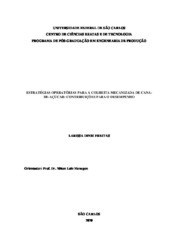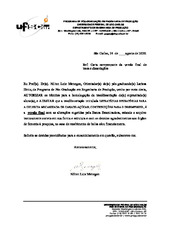| dc.contributor.author | Freitas, Larissa Diniz | |
| dc.date.accessioned | 2020-08-24T19:10:56Z | |
| dc.date.available | 2020-08-24T19:10:56Z | |
| dc.date.issued | 2020-08-06 | |
| dc.identifier.citation | FREITAS, Larissa Diniz. Estratégias operatórias para a colheita mecanizada de cana-de-açúcar: contribuições para o desempenho. 2020. Tese (Doutorado em Engenharia de Produção) – Universidade Federal de São Carlos, São Carlos, 2020. Disponível em: https://repositorio.ufscar.br/handle/ufscar/13188. | * |
| dc.identifier.uri | https://repositorio.ufscar.br/handle/ufscar/13188 | |
| dc.description.abstract | Introduction - The current production rates of the mechanized sugarcane harvest, below those
expected at the beginning of the mechanization process, motivate countless researchers to make
several quantitative methodological attempts in the different dimensions of the activity, in order
to understand how the variables of the mechanized cutting process are correlated and how they
interfere in the performance of the harvesting equipment. However, from a speech by a
harvester operator: “It is the cane that shows the ability for you to walk”, the intelligence of the
worker's practice in his/her activity is revealed, showing his/her fundamental role in the
operational performance through his/her reading of the cane field. Objective - Evaluate how
the technocentric and quantitative variables used in the calculation of the global efficiency of
the sugarcane harvester are influenced by the operator's action, from the perspective of the
ergonomics of the activity. Methods - Qualitative research, the main results of which were
assessed through the Work Analysis of the sugarcane harvester operators under the Course of
Action ergonomic method. Triangulation (observations and interviews) was used as data
collection procedures. Twenty visits were made to the work teams of a sugar-energy plant, in
which 17 were carried out on the sugarcane cutting and loading work team and the other three
on the teams of fertigation, fertilization, planting and harvesting of seedlings, on different days
of the week, in different shifts, varying between 2 to 9 hours in duration. On each visit to the
cutting teams, an operator was accompanied during his/her work shift, from inside the
harvester's cabin. Workers' courses of action were recorded in chronicles and then analyzed in
graphs of tetradic signs. Results - The analysis of the courses of action revealed an operational
logic that is imposed on workers by mechanization and, at the same time, hidden by the
productive indexes. The operator perceives the context of his/her own work and the work of
his/her colleagues to make decisions, prioritizing sometimes the cleanliness of the harvested
mass, the fuel consumption, the losses of cane in the field and the loading flow in the
transshipment; sometimes, the harvesting strategy, the number of maneuvers, the maintenance
of the implements and the release of overflows. This prioritization of actions directly affects
performance indicators, which can be calculated using the data indicated by monitoring
software. Despite this, the OEE was not shown to be sufficient to evaluate the performance in
mechanized harvesting, due to the limitation and loss of data; the extrapolation of what would
be the active time; the disregard for the sugarcane productivity; and, the failure to contemplate
the real conditions of the harvesting equipment and, not even, the operating strategies that the
operators are submitted to develop to create satisfactory indicators for the plant. Conclusion -
Because of the partial availability of the harvester, where problems coexist throughout the
harvesting process, and because of the instability in the production of cane cultivation, which
has variability that automation does not master, the operator is asked to use his skills to do your
job. And, therefore, the greater this competence, the greater the possibilities for action to
generate better indicators. | eng |
| dc.description.sponsorship | Coordenação de Aperfeiçoamento de Pessoal de Nível Superior (CAPES) | por |
| dc.language.iso | por | por |
| dc.publisher | Universidade Federal de São Carlos | por |
| dc.rights | Attribution-NonCommercial-NoDerivs 3.0 Brazil | * |
| dc.rights.uri | http://creativecommons.org/licenses/by-nc-nd/3.0/br/ | * |
| dc.subject | Ergonomia | por |
| dc.subject | Curso da ação | por |
| dc.subject | Mecanização agrícola | por |
| dc.subject | Colhedoras | por |
| dc.subject | Ergonomics | eng |
| dc.subject | Course of action | eng |
| dc.subject | Agricultural mechanization | eng |
| dc.subject | Harvesters | eng |
| dc.title | Estratégias operatórias para a colheita mecanizada de cana-de-açúcar: contribuições para o desempenho | por |
| dc.title.alternative | Operating strategies for mechanized harvesting of sugarcane: contributions to performance | eng |
| dc.type | Tese | por |
| dc.contributor.advisor1 | Menegon, Nilton Luiz | |
| dc.contributor.advisor1Lattes | http://lattes.cnpq.br/5461487552981919 | por |
| dc.description.resumo | Introdução – As atuais taxas de produção da colheita mecanizada de cana-de-açúcar, aquém
das esperadas no começo do processo de mecanização, motivam inúmeros pesquisadores a
realizarem diversas tentativas metodológicas quantitativas nas diferentes dimensões da
atividade, no intuito de compreender como as variáveis do processo do corte mecanizado se
correlacionam e como interferem no desempenho do colhedora. Entretanto, a partir de uma fala
de um operador de colhedora: “É a cana que mostra a capacidade para você andar”, é revelado
a inteligência da prática do operador em sua atividade, mostrando seu papel fundamental no
desempenho operacional através de sua leitura do canavial. Objetivo – Avaliar como as
variáveis tecnocêntricas e quantitativas empregadas no cálculo da eficiência global da
colhedora de cana-de-açúcar são influenciadas pela ação do operador, sob a perspectiva da
ergonomia da atividade. Métodos – Pesquisa qualitativa, cujos principais resultados foram
aferidos por meio da Análise do Trabalho dos operadores de colhedora de cana-de-açúcar sob
o método ergonômico do Curso da Ação. Foram utilizados como procedimentos de coleta de
dados a Triangulação (observações e entrevistas abertas in loco). Foram feitas 20 visitas nas
frentes de trabalho de uma usina sucroenergética, onde 17 foram realizadas nas frentes de corte
e transbordo de cana e as outras três, nas frentes de fertirrigação, adubação, plantio e colheita
de mudas, em diferentes dias da semana e em distintos turnos (matutino, vespertino e noturno),
variando entre 2 a 9 horas de duração. Em cada visita às frentes de corte, um operador foi
acompanhado durante seu turno de trabalho, desde dentro da cabine da colhedora. Os cursos da
ação dos operadores foram registrados em crônicas e, depois, analisados em gráficos de signos
tetrádicos. Resultados – As análises dos cursos da ação revelaram uma lógica operatória que é
imposta aos operadores pela mecanização e, ao mesmo tempo, ocultada pelos índices
produtivos. O operador percebe o contexto de seu próprio trabalho e dos trabalhos de seus
colegas para tomar decisões, priorizando ora a limpeza da massa colhida, o consumo de
combustível, as perdas de cana no campo e a vazão de carregamento no transbordo; ora, a
estratégia de colheita, a quantidade de manobras, a manutenção dos implementos e a liberação
de transbordos. Essa priorização de ações afeta diretamente os indicadores de desempenho,
possíveis de serem calculados com os dados apontados por softwares de monitoramento. Apesar
disso, o OEE não se mostrou suficiente para avaliar o desempenho na colheita mecanizada,
devido a limitação e perdas de dados; a extrapolação do que seria o tempo ativo; a
desconsideração do TCH da cana, informação influente nesse índice; e, a não contemplação das
reais condições da colhedora e, nem mesmo, das estratégias operatórias que os operadores são
submetidos a desenvolver para criar indicadores satisfatórios para a usina. Conclusão - Por
causa da parcialidade da disponibilidade da colhedora, onde problemas coexistem ao longo do
processo de colheita, e por causa da instabilidade da produção do cultivo da cana, que conta
com variabilidades que a automatização não domina, é solicitado do operador o emprego de
suas competências para a realização do seu trabalho. E, por isso, quando maior essa
competência, maior são as possibilidades de ação para gerar indicadores melhores. | por |
| dc.publisher.initials | UFSCar | por |
| dc.publisher.program | Programa de Pós-Graduação em Engenharia de Produção - PPGEP | por |
| dc.subject.cnpq | ENGENHARIAS::ENGENHARIA DE PRODUCAO::GERENCIA DE PRODUCAO | por |
| dc.subject.cnpq | ENGENHARIAS::ENGENHARIA DE PRODUCAO::ENGENHARIA DO PRODUTO::ERGONOMIA | por |
| dc.description.sponsorshipId | CAPES: Código de Financiamento 001 | por |
| dc.publisher.address | Câmpus São Carlos | por |
| dc.contributor.authorlattes | http://lattes.cnpq.br/0762341759642671 | por |


